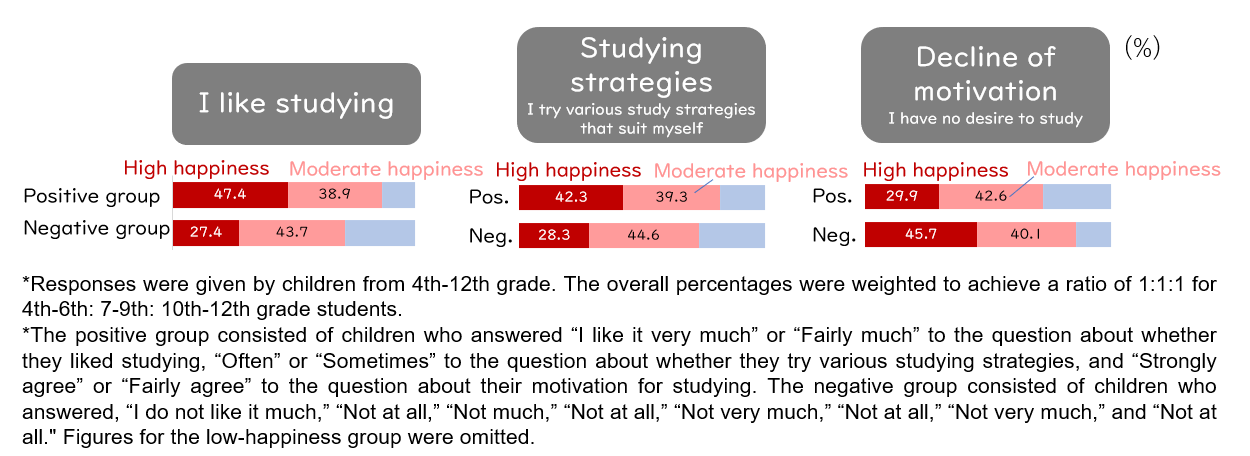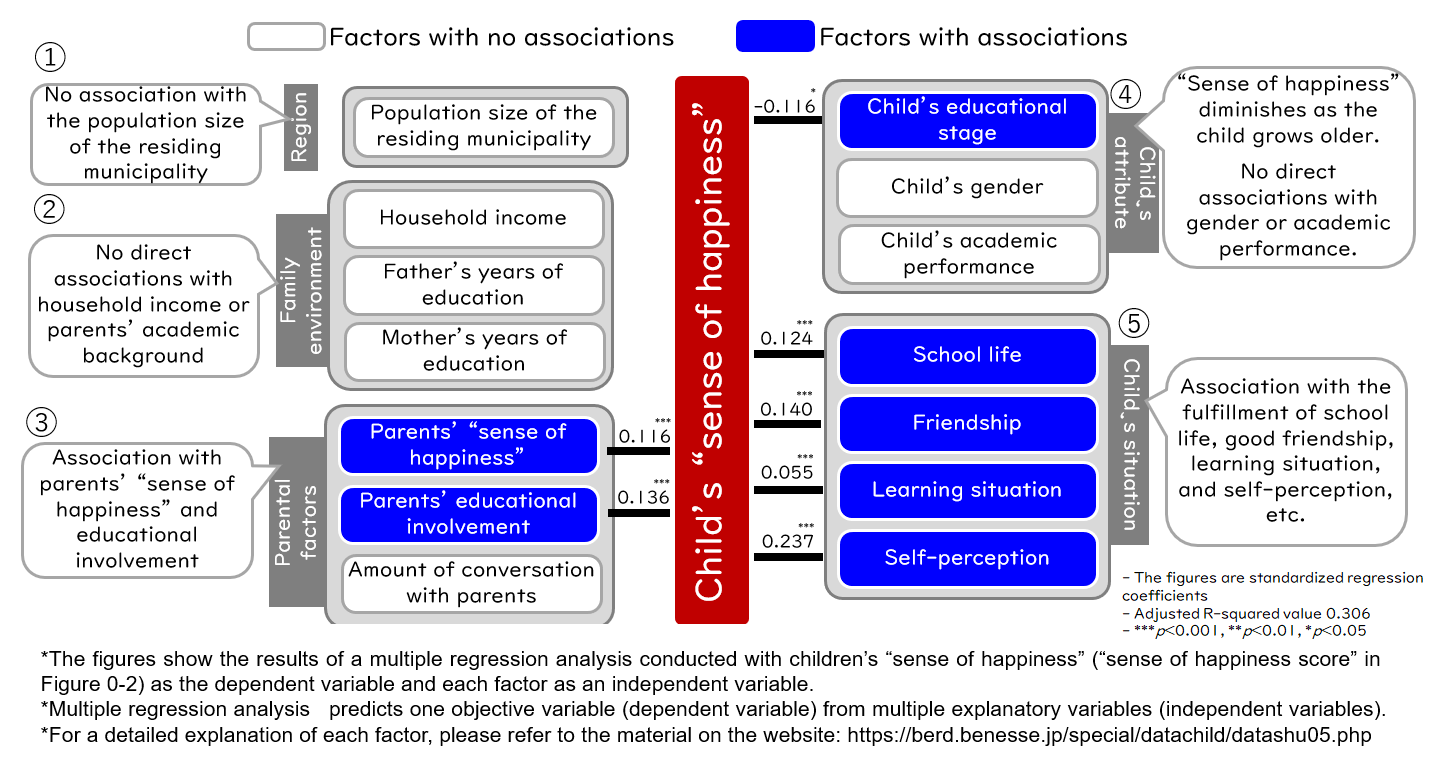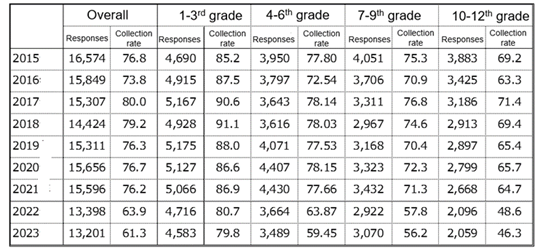The percentage of the "High happiness" group tends to decrease, and the "Low happiness" group tends to increase for children in higher educational stages (Figure 4).

⑤Children's situation - school life, friendships, learning situation, and perceptions of self are associated with their sense of happiness.
- School life - Children who have a fulfilling school life have a higher sense of happiness
Among the children who affirmed that "Classes are fun" (positive group), 43.2% were in the "High happiness" group, while only 20.4% of the children who denied this (negative group) were in the "High happiness" group, more than 20% less than in the positive group. Similarly, children who affirmed "I have teachers I respect" and "I like my school" have a higher sense of happiness than those who denied it (Figure 5-1). - Friendship - Children with better friendships have a higher sense of happiness
Among those who affirmed that they "enjoy being with friends" (positive group), 37.1% were in the "High happiness group," while 17.4% of the children who denied (negative group) were in the "High happiness" group, which shows a difference of nearly 20%. However, children who affirmed "I get tired of being with friends" had a lower percentage in the "High happiness" group (Figure 5-2). - Learning attitude - Children with more positive attitudes and behaviors toward learning have a higher sense of happiness.
Among those who affirmed "I like studying" (positive group), 47.4% were in the "High happiness" group, while 27.4% of those who denied (negative group) were in the "High happiness" group, indicating a gap of 20%. However, children with negative attitudes, such as "I have no desire to study," showed a lower incidence in the "High happiness" group (Figure 5-3). - Perception of self - Children with a positive self-perception have a higher sense of happiness
Among those who affirmed "I have confidence in myself" (positive group), 50.6% were in the "High happiness group," while 21.4% of those who denied (negative group) were in the "High happiness group," showing a gap of 29 percentage points. Similarly, the children in the affirmative group tended to have a higher sense of happiness when asked questions associated with persistence and willingness to accept challenges (Figure 5-4).




[Summary] Achieving the happiness of children
The summary of factors associated and not associated with children's "sense of happiness" is provided below (Figure 6).

- Children's "sense of happiness" is weakly related to attributes
The results of the multiple regression analysis (Figure 6) showed that factors associated with the region (Figure 1), family environment (Figure 2), and children's attributes (Figure 4) did not strongly associate with the sense of happiness. Happiness may be experienced regardless of region, family environment, and children's attributes. However, the children's sense of happiness was observed to decrease as their educational stage progressed. - Children's "sense of happiness" is strongly associated with parents' sense of happiness and educational involvement
Regarding parents' influence (Figure 3), the parents' sense of happiness and involvement with the child were associated with the child's sense of happiness. Parents' own situation and their involvement with their children are important for children's happiness. - Many factors are relevant in children's "sense of happiness," including a fulfilling school life, good friendships, learning status, and self-perception
Various factors related to the child's situation (Figure 5) are also associated with the child's "sense of happiness."
◆School life
Factors such as enjoyment in class, stable relationships with teachers, and attachment to school are all associated with the "sense of happiness." Building a fulfilling school life improves children's sense of happiness.
◆Friendship status
Children with positive relationships with friends tend to experience more happiness than those with a strong negative attitude. Building stable friendships is also significant in realizing happiness.
◆Learning situation
Children who liked studying and were creative in their learning tended to have a high sense of happiness. However, children with low motivation to learn showed a low sense of happiness. The fulfillment of learning activities is also an important factor for happiness.
◆Perception of self
Self-confidence, perseverance, and a willingness to accept challenges are also associated with the "sense of happiness." Enhancing traits and competencies, often referred to as non-cognitive skills, is likely to improve the sense of happiness.
Our results showed that a child's "sense of happiness" is associated with a complex combination of factors. However, stable relationships at home and school and fulfilling daily activities are important. Adults must provide an environment where children feel secure and can express their strengths and competencies. Children are likely to act independently within this context. In this project, we would like to use this analysis as an opportunity to think together with many people about what we can do to realize a society in which children and their parents can feel happy.
Survey Summary
| Title | Japanese Longitudinal Study of Children and Parents (JLSCP) 2015-2023, 1-9th Survey. |
|---|---|
| Research Theme | Children's Survey: Children's Attitudes and Actual Conditions Concerning Life and Learning Parent Survey: Parents' awareness of child-rearing and education *Only parents were surveyed for 1st -3rd grade. |
| Period | From July to September of each year |
| Method | 2015: Survey by mail and online combined; 2016-20: Survey by mail; 2021: Survey by mail and online combined; 2022-2023: Online survey |
| Samples | Children in 1st-12th grade and their parents nationwide (only parents participated for 1st-3rd grade) *Registered respondents for this research project. Below are the sample sizes (parent-child pairs) for each year. The collection rate is indicated in %.  |
| Members of Children's Life and Learning Research Project | ● Project Leaders Kaori Sato (Professor at the University of Tokyo) and Yuki Nozawa (General Manager of Benesse Educational Research & Development Institute) ● Project Members Hiroaki Mimizuka (Professor emeritus at Ochanomizu University, visiting professor at Aoyama Gakuin University), Kiyomi Akita (Professor at Gakushuin University, Professor emeritus at the University of Tokyo), Kayo Matsushita (Professor at Kyoto University), Hiroshi Ishida (Distinguished professor at the University of Tokyo), Sho Fujihara (Associate professor at the University of Tokyo), Shiroh Ohno (Project associate professor at the University of Tokyo), Hiroko Osaki (Project associate professor at Rikkyo University), Haruo Kimura (Principal researcher at the Benesse Educational Research & Development Institute), Runa Matsumoto (Senior researcher at the Benesse Educational Research & Development Institute), Yumiko Fukumoto (Researcher at the Benesse Educational Research & Development Institute), Masataka Tomonaga (Researcher at the Benesse Educational Research & Development Institute), Satoshi Okabe (Senior researcher at the Benesse Educational Research & Development Institute), Koji Nakajima (Senior researcher at the Benesse Educational Research & Development Institute), Hatsue Ouchi (Research staff at the Benesse Educational Research & Development Institute), and Mio Watanabe (Research staff at the Benesse Educational Research & Development Institute) ● Research Working Group Members Kosuke Sudo (Associate professor at Meisei University), Ryosuke Onoda (Associate professor at the Graduate School, University of Yamanashi) *Titles and affiliations are as of February 2024 |
*Notes and Notations Concerning Data
Percentages (%) used in this document are rounded to the first decimal place of the values obtained according to the calculation method for each item. Therefore, the sum of the values may not total 100.
Additional data on the survey
For more detailed data, please visit the Benesse Educational Research and Development Institute website (in Japanese). You can download this document and a report summarizing the survey results.
For data not presented here or by educational stages, please see below.
https://berd.benesse.jp/special/datachild/datashu05.php














